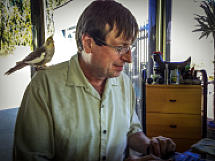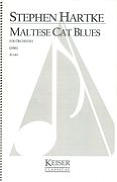
Stephen Hartke
MALTESE CAT BLUES (1986)
Louisville Orchestra Prize -- 1987
Duration: 16 Minutes
Orchestra
Piccolo, 2 Flutes (2nd doubles Piccolo 2), 2 Oboes, English Horn, E-flat Clarinet, 2 B-flat
Clarinets, 3 Bassoons, 4 Horns, 3 Trumpets, 3 Trombones, Tuba, 4 Percussionists
(Crotales, Marimba, Vibraphone, Small Snare Drum, 3 Tom-toms, Bass Drum, 2
Suspended Cymbals, Hi-Hat Cymbal, Small Triangle, High Wood Block, Maracas,
Whip), and Strings
Maltese Cat Blues takes its title from a song by Blind Lemon Jefferson. Years ago I heard a
recording of Sleepy John Estes singing his own version of it, which begins, "Oh them rats
is mean in my kitchen." The melody has since faded from my mind, but the style of
singing, with its energetic speech-song and wailing, typical of early blues, fixed itself in
my memory. In 1985, while living in São Paulo, Brazil, on a Fulbright grant, I underwent
that sharpening of my sense of national identity which almost inevitably results from a
prolonged stay abroad. That memory of Sleepy John's singing resurfaced and prompted
me to compose a piece as an homage to the spirit of early blues performance.
The work is in four main sections. The first in an introductory blues stanza that begins
with high wailing in the piccolos and violins, and then works its way down to an
extended, ruminative solo for tuba. The entrance of a jazzy violin solo begins the second
part, a faster dance-like section in A-B-A form. The third section involves the dramatic
opposition of two different musics: first, a lazy rocking figure that sometimes supports a
simple tune; and second, a rapid, scampering patter in the woodwinds, punctuated by
sudden high squeaks and insistent trumpeting figures. The fourth part is the longest,
presenting two blues verses and refrains, and ending with a fast coda. The first verse is in
declamatory style, the trumpets' melody bisected by full orchestral chords. The refrain is
quiet, lightly scored, and audibly based on a standard blues progression. In the second
verse, the strings moan the melody in unison, and the refrain returns, now slower and
more forceful. The coda takes up ideas from parts two and three, combining them with a
powerful, rhythmic drive toward the conclusion. At the very end there is a final outburst
of melody that springs from the speech-rhythm of the line: "Oh them rats is mean in my
kitchen."


















